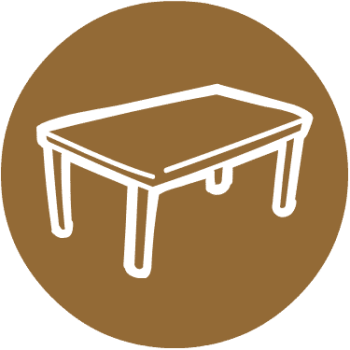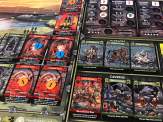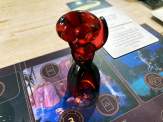| Release Date: 2025 | Players: 1-4 |
| Designer: Orlando Sá | Length: 45-75 minutes |
| Artist: Álex Herrerías | Age: 12+ |
| Publisher: Osprey Games | Complexity: 2.5 / 5 |
| Plastic (by weight): <1% | Air (by volume): 65% |
It is time for the Day of the Dead, the Día de los Muertos. It is also time to prepare our altar of family portraits with beautiful marigolds and candles to remember those who have passed away. Soon, we will make offerings of the things they loved, to guide their spirits back to us. At the same time, we have to be very careful how we arrange the photos. Like in any family, not everyone is happy to be right next to just anyone in our Ofrenda by Orlando Sá and André Santos from Osprey Games with art from Álex Herrerías.
Listen to the Audio Version
Intro Music: Bomber (Sting) by Riot (https://www.
Music: “harder” provided by mobygratis.
Music: “death in the afternoon” provided by mobygratis.
I love games that create little puzzles where you have to select tiles or cards and place them in such a way as to gain the most points. You can never achieve everything and have to accept that you have to give up on certain goals in favour of scoring heavily somewhere else. These types of games can induce analysis paralysis in some people, but for me, they fire up certain parts of my brain that deposit a large dose of dopamine.
Ofrenda is part of a long line of 2D spatial puzzle games that include favourites such as My Shelfie or Patchwork. Yet, it has a few differences to these and other classics, which make it a game that will stay in my collection and come out more frequently than them.

Spatial Ofrenda Puzzle
First of all, there is the theme. A game about arranging portraits of deceased loved ones on an altar and decorating everything with candles and marigolds is very evocative. It’s a very cosy theme that makes Ofrenda the perfect Halloween game. While it might seem a bit morbid to some, celebrating the life of family members who are no longer with us is actually very inspiring and emotional. Showing our love for the people who have moved on is something we don’t do enough in our lives, I think.
Secondly, while Ofrenda has traditional drafting of cards and tiles, each card is a mini objective, which you combine with the additional objectives of the candle tokens. As you place a portrait card in your altar player board, you need to make sure that you don’t mess up the requirements of the other cards you have already placed.
Each card is a combination of a colour and a gift and shows what other types of cards it does or does not want around it. For example, a green card with a water symbol on it may have the requirement that it needs to be next to at least two cards that are either orange or a salt gift – or both. That sounds simple enough when you have two salt cards in your hand. However, when one of the salt cards’ requirements is that it must not be next to any green cards, you have a problem.
Of course, the problem gets more and more complex, the more portraits you add to your ofrenda altar. Eventually, you have to concede that some of your cards will just never meet their requirements. You have to give up on that card and focus your efforts somewhere else instead.
Picky Spirits
In addition to placing portrait cards, you also place candles, which have their own objectives on them. However, instead of being about what else is next to them, they score if their requirements are met across the whole of the altar. For example, a candle may require that you have at least four salt cards in your ofrenda. So the candles are much easier to handle.
The real challenge in Ofrenda is a level deeper though. It’s not just about meeting the requirements of the portrait cards and candles, but the devil is in the scoring. Any card or candle whose objective has been met scores based on the portrait cards around it whose objectives have also been met. So it’s no good to have successfully met the requirement of a candle if none of the adjacent portraits have met theirs.
The same goes for the marigolds that you can place in your ofrenda, which also function as a sort of currency in the game, which you use to pay for cards that you draft and for placing portraits in certain locations on your player board.
So the scoring is the really tricky bit in Ofrenda. You want to have clusters of cards that have all met their requirements to score the maximum amount. If you have half of your portraits successfully meet their requirements, but it’s every other card, you won’t score much. If half the cards are all next to each other though, then you’re going to be all right.
You need to plan ahead the best you can. You have three cards in your hand and every turn, you draft one from the offer row. So you have a good amount of information to make a judgement call on what requirements you’re most likely to meet.

Drafting
Of course, the more often you play Ofrenda, the better you will get. You will also start to realize that there is a certain amount of hate drafting involved. If you can spot what card another player needs, you may want to take it and stop them from scoring high. However, you have to be careful that it doesn’t limit your own choices and prevent you from fulfilling your own altar’s goals. I just wanted to mention it, because some people don’t like games where hate drafting is possible.
Overall though, Ofrenda is a really lovely game about arranging family portraits in the same way as you would arrange people at a dinner party. You want to make sure the right people are next to each other and avoid people who don’t like each other sitting side by side.
The illustrations are really fitting and family-friendly. The double-sided cards show a ghostly image of a person on one side and their live portrait on the other. The marigold wooden tokens are a lovely little addition. They stand out against the cardboard candle tokens and are really tactile. The dual-layer player boards that represent your ofrenda have holes cut in them to make it easy to remove the portrait cards afterwards.
Playtime is also really good. The game lasts exactly 12 rounds. There is no risk of it going on forever, even if someone in the group has analysis paralysis. If anyone does struggle, you just have to remind them that they won’t complete everything. Of course, that could trigger OCD anxiety instead, so don’t play Ofrenda with anyone who may hate it that they’re unlikely to end the game with a perfect picture.
Other than that, I can’t wait to play Ofrenda again. It’s the perfect game that scratches all the right itches for me.
For behind-the-scenes updates, branded merchandise, and more, please support the blog.
Useful Links
- Ofrenda: https://www.
ospreypublishing. com/ uk/ ofrenda-9781472868787/ - Osprey Games: https://www.
ospreypublishing. com/ uk/ - BGG listing: https://boardgamegeek.
com/ boardgame/ 432705/ ofrenda - My Shelfie review: https://tabletopgamesblog.
com/ 2023/ 09/ 02/ my-shelfie-saturday-review/ - Patchwork review: https://tabletopgamesblog.
com/ 2020/ 11/ 21/ patchwork-digital-eyes/
Transparency Facts
I feel that this review reflects my own, independent and honest opinion, but the facts below allow you to decide whether you think that I was influenced in any way. Please also read my Ethics Statement for more information.- I was given a free review copy of this game by the publisher.
- At the time of writing, I have not received financial support from the publisher or anyone working on their behalf.
Audio Version
Intro Music: Bomber (Sting) by Riot (https://www.
Music: “harder” provided by mobygratis.
Music: “death in the afternoon” provided by mobygratis.
Playlist
These are the songs I listened to while I was writing this review:






